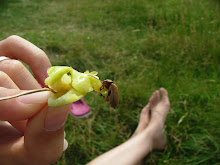Reach higher
How to Teach Phonics (2)
1) Heads Down & Arms Up
Example: Have Ss put their head down on the table, and tell them to listen to the short “a” sound. If they hear a word with “a” sound, they need to raise arms. If not, keep their head down.
The first time I did this, some students would look up to see if they were making mistakes. I had to keep telling them to put their head down. The second time I did it, the students were more comfortable because I told then in the first round that they would not have to worry about making mistakes. If they did, all I would do was to tell them to listen more carefully. Most students did better the second time. I think the advantage about this game is that I can see clearly which students can really tell the different sounds, and which ones still have trouble doing it.
2) Stand Up and Be Counted
Example: Have students write down words with different sounds like the short vowels on several pieces of memo size paper. Choose one student to come to the front. When he/she show one of the word he has and saying it out loud. Other students who have words with the same vowel need to stand up and say the words they have in their hands.
This game was fun because all my students wanted to be the teacher (they think they are the teacher when they come to the front of the classroom). I make an extra rule that the slowest student standing up/finishing saying the word by have to do five jumps. Others thought it was funny to watch and the slowest student thought it was fun to do the jumps, too.
3) Back Spelling
Example: Write down five words with short vowels on five pieces of paper. Paste them on the students’ backs, and have the students to ask each other to read the word on the backs. The students have to write down the vowel that’s in the word on the whiteboard after hearing the words said to them.
I don’t really like this game because the students try to cheat too much. Instead of listening to the words, they will ask each other, “Is it ‘e’?” However, if you just want to give them a chance to get off their chairs and move around for a while, this game is pretty good for that purpose.
4) Eat your words: Use chopsticks to pick up small pieces of paper with letters on, and combine them to make a word. (Example: r + ai +n à makes “rain”.)
5) Make a Poem: Have students create their own poem by using words with the same phonemes.
How to Teach Phonics
Building Spelling and Pronunciation Through Games and Activities
by Todd Hess
1. Why teach phonics?
An. When a person can use correct pronunciation for a word or a sentence, then successful communication is possible.
Example: This guy is falling.
2. What are phonemes?
An. Phonemes are different sounds within a language.
3. Phonemic transcription:
1) There are 26 letters in the English alphabet.
2) There are 21 consonants.
3) 24 consonant sounds.
4) 5 vowels.
5) 20 vowels sounds.
There are totally 44 phonemes in English. (24 + 20)
4. What difficulties that individual learners have?
1) Lack of a 1 to 1 relation between spelling and pronunciation in English.
2) Alphabet & Phonics are overlapped.
3) There are sounds and combinations of sounds that are in Chinese that are not in English.
4) English has stress and tones (for not only words but also sentences).
5) Other: Pronunciation teaching is often neglected. It’s usually not part of the curriculum/program/lesson planning.
5. Teachers of pronunciation need:
1) A good understanding of theoretical knowledge
2) Practical classroom skills
3) Acess to good ideas for classroom teaching
6. Techniques and Activities
1) It’s more important to teach the final sound of a letter not the initial sound. Eg. Mom à teach m sound as /m/ instead of /mə/
2) Point out the difference between voiced and unvoiced sounds. Eg. /t/ & /d/
3) Deductive Approach and Productive Approach
7. More Techniques:
1) For better pronunciation: I say. You say
2) Best done before they see the written form of the new language.
3) Drilling:
a. Choral drilling: Help build confident.
b. One-on-one drilling: allow Ts to see how each S is doing.
c. Chain Driving: by sentence or by word
d. Front Chaining: sp, spoo, sppok, pooki, pokiest (Break it into ridicules.)
e. Back Chain: a fest., need a fest, Jake needs a fest.
f. Substitution drilling: change only one phonemes. (Eg. nat, nut, not, nit..)
4) Mimal pairs: words or utterances which differ by only one phoneme. They show the phonemic principle of changing just one sound can lead to the change of meaning. (Eg. cap & cape, goat & coat)
5) Listening Activities (Respective method)
6) Reading: circle all the “ai” with a yellow marker, all the “ay with a blue marker….
7) Recording the students: a good way for Ss to find what they are doing wrong.
7. Activities 1) Heads Down & Arms Up
2) Stand Up and Be Counted
3) Back Spelling
4) Eat your words
5) Make a Poem
I have learnt a couple new concepts from this workshop, and many useful techniques and activities. I have applied some of them in my teaching, and I found there were games more suitable for elder kids that didn’t work as well for younger kids (or vice versa).

